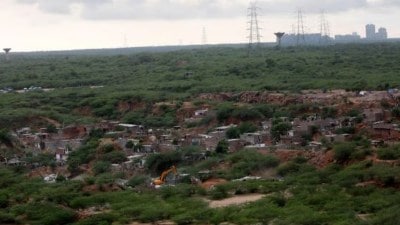Stay updated with the latest - Click here to follow us on Instagram
‘Unprecedented’ rainfall takes J&K toll to over 100, roads, power down
Thousands have been rendered homeless, with more than 25,000 villages submerged and the loss to property and crops running into hundreds of crores.
 Chief Minister Omar Abdullah drove Rajnath Singh to Baghat, Barzulla, Rambagh, Jhelum Bund, Zero Bridge, Budshah Bridge, Exhibition Chowk, Saria Balla and other areas in the main city. (Source: Shuaib Masoodi)
Chief Minister Omar Abdullah drove Rajnath Singh to Baghat, Barzulla, Rambagh, Jhelum Bund, Zero Bridge, Budshah Bridge, Exhibition Chowk, Saria Balla and other areas in the main city. (Source: Shuaib Masoodi)
With no let-up in rains for the fifth day on Saturday, the death toll in Jammu and Kashmir’s worst flood in six decades has risen to 107. The Army, involved in rescue operations across the state, has termed the situation as grim as after last year’s Uttarakhand flash floods.
Thousands have been rendered homeless, with more than 25,000 villages submerged and the loss to property and crops running into hundreds of crores.
Weather officials, however, expect the rains to stop soon. “Tonight there will be more rains, but hopefully from Sunday, weather will improve,” Director, Srinagar Met Department, Sonum Lotus said.
India Meteorological Department, Pune, expects the rains to cease in the next couple of days. Weather scientists also said that while the amount of rainfall in Jammu and its adjoining areas, the worst affected, over the past few days was unusual, the cause behind it was not.
 Drivers of a medical van came out as they wait for the evacuation in the Athwajan- on the city outskirts on Friday. (Express photo by Shuaib Masoodi)
Drivers of a medical van came out as they wait for the evacuation in the Athwajan- on the city outskirts on Friday. (Express photo by Shuaib Masoodi)
During this time of the year, heavy rainfall in north and northwestern parts of India is generally a result of interactions of western disturbance with the monsoon winds. In Jammu too, the incessant heavy rainfall has been caused by two strong interactions of western disturbances with monsoon.
“Meteorologically, there is nothing unusual. However, the amount of rainfall, no doubt, is unexpected,” said D S Pai of IMD, Pune.
Western disturbances are rain-bearing winds that originate beyond Afghanistan and Iran, picking up moisture from as far as Mediterranean Sea, unlike the monsoon that comes from south of the Arabian Sea and the Bay of Bengal.
“We have seen such interactions result in heavy rainfall in Uttarakhand, even Rajasthan. A couple of years ago, the largescale flooding in Pakistan was a result of such interactions. But what we have seen in Jammu is certainly unprecedented. I am not aware of something similar happening in that area,” Pai said.
Three major highways in J&K — Srinagar-Jammu, Srinagar-Leh and Mughal Road — are all closed due to massive landslides. A major portion of the Jammu-Srinagar national highway has been swept away. Rail service on the Jammu-Udhampur-Katra stretch and Banihal-Qazigund-Baramulla has remained suspended for the last three-four days following landslides.
 A collapsed crusher machine on the banks of raging Tawi river in Jammu on Saturday. (Source: PTI)
A collapsed crusher machine on the banks of raging Tawi river in Jammu on Saturday. (Source: PTI)
In South Kashmir, communication links are down, while many areas continue to be without power and drinking water. Several parts of Jammu city have not had electricity or water supply since Friday night.
On Saturday afternoon, nine Armymen men on rescue mission were washed away in Kakapora, Pulwama, of which seven were found later. The fate of the other two remains unknown.
The Congress has demanded that the floods be declared a national calamity. Leader of Opposition in the Rajya Sabha Ghulam Nabi Azad, who is in Srinagar, spoke to Prime Minister Narendra Modi on phone and sought his personal attention in view of the “very grave and grim situation”.
 A family in the outksirts of Srinagar is living in a truck since last four days. (Source: Express photo by Shuaib Masoodi)
A family in the outksirts of Srinagar is living in a truck since last four days. (Source: Express photo by Shuaib Masoodi)
VIEW MORE PICTURES HERE: Flood fury in Jammu and Kashmir; 100 feared dead, 2600 villagers affected
Union Home Minister Rajnath Singh, who surveyed the affected areas in both Kashmir and Jammu regions Saturday, assured the state government of all help. “The Prime Minister has announced Rs 2 lakh ex-gratia relief to next of kin of those who died and Rs 50,000 for those injured,” he said. The Centre has also sent six helicopters to help in rescue operations.
Worried over rising waters, the Jammu administration blocked vehicular movement over many bridges in Chenab and Tawi rivers Saturday. Jammu region has been the worst affected, especially Rajouri and Poonch, with 100 of the 107 deaths reported from there.
At many places, people are living on roads or have turned vehicles into temporary shelters. Thousands of pilgrims are stranded at Katra, with the pilgrimage to the Vaishno Devi shrine suspended.
Two major hospitals in Srinagar — its lone Bone and Joint Hospital and Jhelum Valley Medical College Hospital — had to be closed Saturday after floodwater entered the premises. Patients admitted there have been shifted to other hospitals or discharged.
 A portion of the Bhagwati Nagar bridge over river Tawi collapsed following heavy rains and floods in Jammu on Saturday. (Source: PTI)
A portion of the Bhagwati Nagar bridge over river Tawi collapsed following heavy rains and floods in Jammu on Saturday. (Source: PTI)
While in Srinagar, Jhelum was flowing above the danger mark, it breached embankments at several places in Pulwama and Anantnag districts. “I have never seen such a bad flood in my life,” said Wali Mohammad, who had to leave his house in Pandrethan along with family.
The government has issued a fresh warning to people living in the vicinity of rivers and streams to immediately shift to safer areas.
In the 24 hours between the morning of Friday and Saturday, Jammu received as much as 21 cm of rainfall, the maximum in the country. The adjoining Katra received 21 cm, according to data released by IMD. Bhaderwah, Banihal and Gulmarg were the other places that received very high rainfall. Almost every place in Punjab and Haryana, including Amritsar, Karnal, Patiala, Chandigarh, Gurdaspur and Ambala, also received high rainfall due to western disturbances.
Commissioner Secretary, Revenue and Relief, Vinod Koul said that as per latest reports, 390 villages had been submerged in the Valley while 1,225 were partially affected, while in Jammu division, a thousand villages had been affected. Besides, Koul said, 50 bridges and hundreds of kilometres of roads as well as power installations had been damaged.
Chief Engineer, Flood Control and Irrigation Department, Javid Jaffer said while the state’s river and flood channels could carry 65,000 cusecs of water, the current discharge was over 90,000 cusecs.
The Army has pressed 110 columns, including 17 engineering columns, into service. The state government has also called six special teams of the National Disaster Rescue Force from Ambala in Haryana for rescue operations.
The Army has rescued more than 13,000 people so far. On Saturday, its High Altitude Warfare School, Sonamarg, rescued 10 nomads, including a small girl. Ten tourists were rescued at Nitchnaie.







